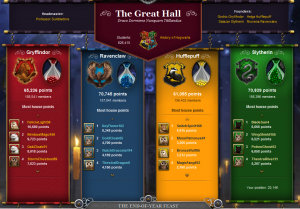In “Searching for the Origami Unicorn,” Henry Jenkins writes, “a transmedia story unfolds across multiple media platforms, with each new text making a distinctive and valuable contribution to the whole.” The first transmedia story I thought about was Harry Potter. It is a fantasy series written by J.K. Rowling that follows the life of a young wizard named Harry Potter. The series has 7 books that are a phenomenon. Over 400 million copies of the books have been sold worldwide. The book has been adapted into films that have been released over the course of 10 years. There have also been video games that were made after the books/films success. There are videogames on all video game consoles. There is even a Lego Harry Potter – which combines two big franchises. There are also countless fan-fiction stories written about Harry Potter.

One of the most spectacular platforms that have been created for the Potterhead fanbase is Pottermore.com. This is a website where fans can create accounts, explore the story deeper, get sorted into their own Hogwarts house, play games, take quizzes to find out their Patronus, and more. This is an incredible virtual experience that keeps the world of Harry Potter alive – even after the books and movies have ended.

Like many of the other franchises that have been talked about in other people’s blog posts, Harry Potter has an amusement park located in Universal Studios in Orlando. People can ride rollercoasters and rides that mimic flying on a broom, eat the food/candies that have been coined by J.K Rowling, and even buy their own wand to use around the park. This furthers people’s experience and actually brings to life the world that people have only read, watched or played in a video game.
Not only that, but there is also a Harry Potter convention called LeakyCon in 2018 that people can attended – alleged to be the largest Harry Potter convention ever. It is taking place in Dallas, Texas.
Harry Potter is the epitome of transmedia storytelling because it comes across so many different platforms: book, film, video game, and website.
Word Count: 350
Works Cited:
Jenkins, Henry. “Searching for the Origami Unicorn.” Convergence Culture: Where Old and New Media Collide, New York University Press, 2006, pp. 93–130.
